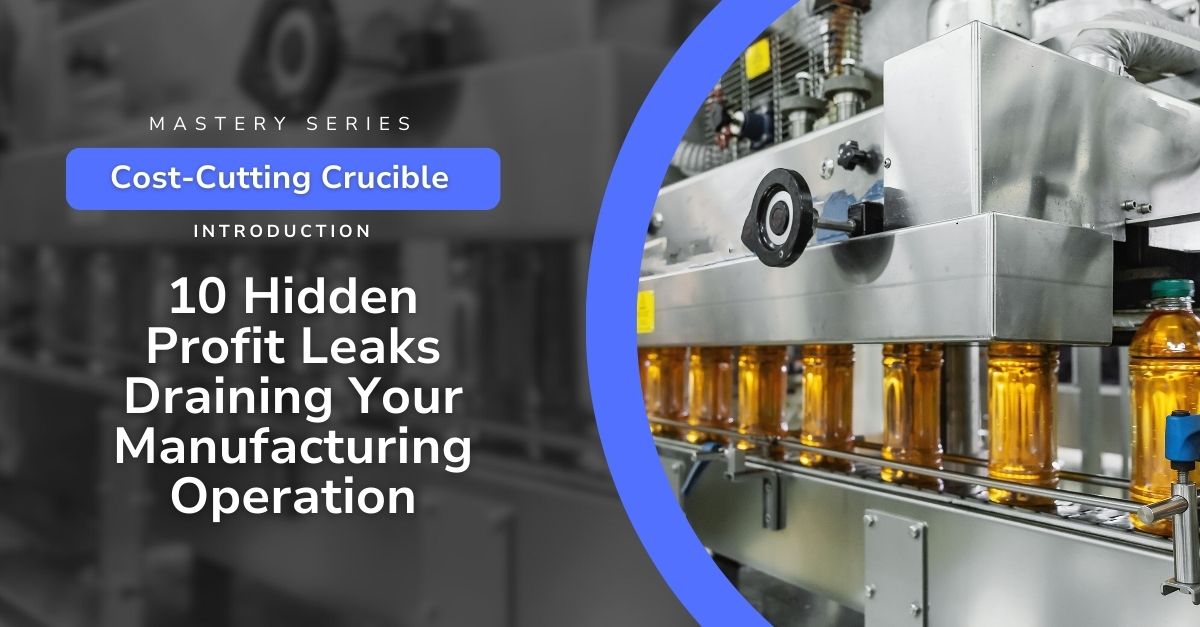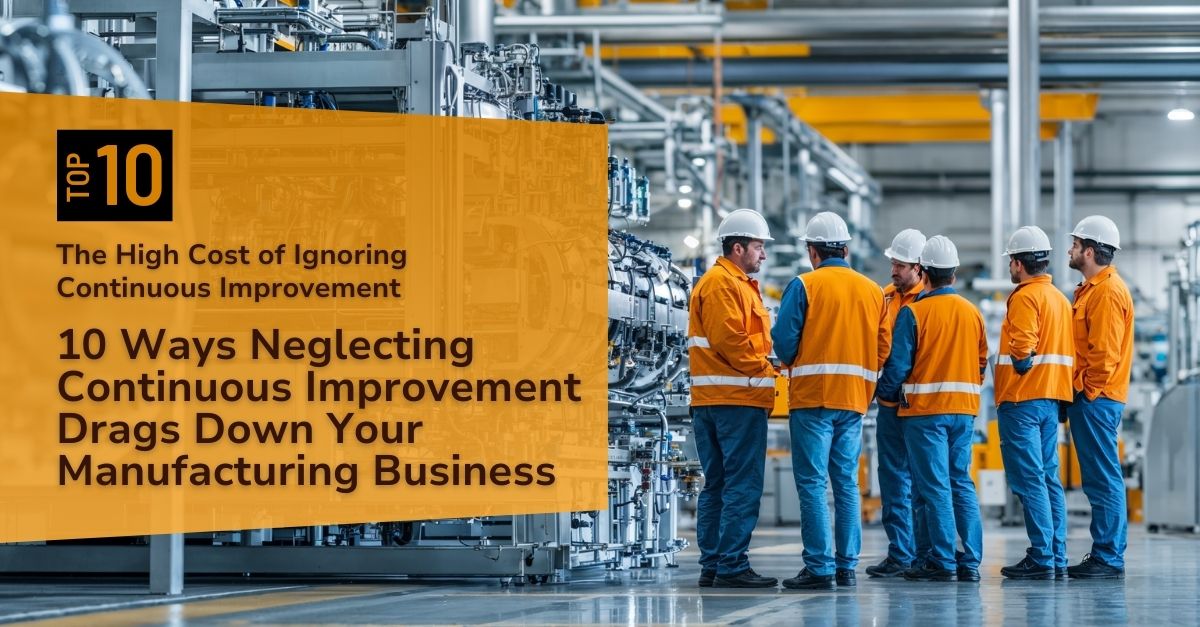
Manufacturing is a cornerstone of global economies, driving innovation, employment, and economic growth. However, companies face many challenges threatening their competitiveness, profitability, and long-term sustainability.
Among these challenges, rising operational costs are a critical hurdle that can stifle growth and dampen innovation.
From the surge in raw material prices to the increasing costs of labor, energy, and compliance with environmental regulations, manufacturers constantly battle to keep their expenses in check while striving to maintain quality and meet consumer demands.
This complex scenario is further exacerbated by global economic fluctuations, supply chain disruptions, and the push toward sustainability, which, while essential, adds another layer of operational considerations and investments. The interplay of these factors makes it increasingly difficult for manufacturing companies to achieve their financial goals and sustain growth without significantly changing their operational strategies.
In this detailed exploration, we delve into the top 10 ways increased operational costs harm or hamper manufacturing companies and provide actionable insights and positive steps manufacturers can take to mitigate each challenge. Our discussion is rooted in credible sources and factual data, offering a comprehensive guide for manufacturers seeking to navigate the turbulent waters of rising operational costs.
By understanding the nuances of these challenges and implementing the strategies outlined herein, manufacturing companies can transform operational costs from a burden into a catalyst for innovation, efficiency, and sustainable growth. This journey requires a proactive approach, where every aspect of the operation is analyzed, optimized, and aligned with the broader sustainability and profitability goals.
1Reduced Profitability:
The issue: Increased operating costs eat directly into profit margins, especially when price increases cannot be passed on to customers. Over time, that limits reinvestment, reduces agility, and creates long-term financial strain.
What to do: Start by identifying and eliminating non-value-adding activities across your operation. This includes excessive motion, overproduction, and unnecessary handling, classic forms of waste in lean methodology. Invest in energy-efficient systems and predictive maintenance to reduce unexpected costs. For immediate wins, review material usage, scrap rates, and shift-level labor efficiency to spot controllable cost drivers. Don’t just track performance monthly, track it daily and tie it to frontline decision-making.
2Diminished Competitiveness:
The issue: When costs rise faster than revenue, it becomes harder to compete on price or speed. Customers notice when your lead times slip or your pricing lacks flexibility. The result is lost orders and shrinking market share.
What to do: Shift your competitive advantage from cost to value. That means differentiating with higher quality, faster turnaround, or tailored services. Invest in frontline problem-solving skills that reduce customer complaints, improve on-time delivery, and increase responsiveness. Equip sales and operations teams to work more closely so production plans align with changing market demands. Value-based pricing supported by better performance gives you room to protect margins.
3Eroded Margins:
The issue: Eroded margins don’t just impact profitability, they hinder strategic investment. Without margin flexibility, it’s harder to fund new product lines, technology upgrades, or expansion plans.
What to do: Tackle indirect costs just as aggressively as direct ones. Many organizations focus heavily on materials and labor but overlook administrative processes, slow approvals, or expensive workarounds. Use value stream mapping to uncover delays and inefficiencies across functions. Build partnerships with suppliers and logistics providers to lock in long-term savings. And consider alternate pricing models or revenue sources such as service agreements or volume-based contracts that stabilize cash flow.
4Production Delays:
The issue: Budget pressures often lead to cuts in training, maintenance, or staffing. These decisions might save money in the short term but frequently cause unexpected production delays that are far more costly.
What to do: Invest in scheduling discipline and cross-training. Many delays stem from limited flexibility when labor or equipment becomes unavailable. Build a better MOS, a Management Operating System that aligns shift handoffs, visual performance tracking, and escalation routines. Equip supervisors with the tools to solve issues before they require plant-wide interventions. Automating key processes or workflows, even in small ways, can help prevent production from stalling.
5Quality Issues:
The issue: In cost-cutting mode, quality sometimes slips. Cheaper materials, reduced inspection time, or overworked operators often lead to inconsistent output or product failures. Over time, this undermines trust and inflates warranty or rework costs.
What to do: Double down on preventive quality management. Create a consistent process for root cause analysis when defects occur. Train frontline teams to own quality, not just monitor it. Standardize work instructions and give employees a mechanism to report problems and stop the line if necessary. Improving quality doesn’t always require expensive equipment; it often requires better communication, clearer standards, and consistent follow-up.
6Employee Morale:
The issue: When the focus shifts entirely to cutting costs, employees feel it. Wage freezes, layoffs, or reduced hours can lead to lower engagement, missed targets, and higher turnover.
What to do: Communicate openly about business realities and give employees a voice in shaping solutions. Involving teams in identifying cost savings, improving work areas, or testing process changes increases buy-in and often yields better results. Recognition doesn’t need to cost money, visibility, respect, and opportunities for growth matter just as much. Even modest changes to scheduling flexibility, break areas, or peer recognition can improve retention and output.
7Supplier Relationships:
The issue: Trying to negotiate your way out of rising costs by squeezing suppliers often backfires. Short-term savings may come at the expense of reliability, lead time, or collaboration.
What to do: Treat key suppliers as strategic partners, not just vendors. Share demand forecasts and production schedules. Work together on packaging, logistics, or process improvements that reduce cost for both parties. Explore vendor-managed inventory models or consignment stock for critical parts. Building trust and transparency improves response time and cost predictability over the long run.
8Innovation Stagnation:
The issue: As operating budgets tighten, R&D and continuous improvement efforts are often the first to be deprioritized. This slows innovation and makes it harder to respond to customer needs or shifts in the market.
What to do: Protect innovation by embedding it into daily work rather than relying solely on special projects or separate teams. Create short, focused improvement sprints that solve real problems on the floor. Use pilot programs to test new ideas on a small scale with minimal risk. Consider partnerships with technical schools, research labs, or even customers to co-develop new solutions. Innovation thrives in environments that support learning, experimentation, and quick feedback, none of which require massive capital.
9Environmental Impact:
The issue: When operational costs spike, sustainability efforts are often the first to be scaled back. But deferring green investments can lead to fines, higher utility bills, or reputational damage that costs far more over time.
What to do: Focus on cost-saving sustainability first. That includes energy audits, compressed air leak detection, and scrap reduction. Apply kaizen events to reduce water or material waste. Look into local, state, or federal incentives for upgrades like LED lighting, solar, or electric vehicle infrastructure. Often, the projects that help the planet also cut expenses and reduce long-term risk.
10Long-term Viability:
The issue: The cumulative effect of rising costs, if left unchecked, threatens the long-term stability of the business. Decision-making becomes reactive. Performance degrades. The company loses its ability to compete or pivot.
What to do: Build a disciplined cost management system that ties strategy to execution. This includes setting clear financial targets, measuring performance daily, and empowering teams to adjust quickly. Forecast costs and profitability in rolling windows, not just yearly. Reinforce behaviors that support sustainability, efficiency, and accountability across the entire operation.
Conclusions for Manufacturing Operations Leaders: Turning Challenges into Opportunities for Sustainable Growth
The rising tide of operational costs in the manufacturing sector is more than just a challenge; it’s a clarion call for strategic adaptation and innovation. As demonstrated throughout this exploration, these formidable challenges also present unique opportunities for growth, efficiency, and long-term sustainability. By implementing cost-effective measures, prioritizing innovation, and embracing sustainable practices, manufacturing companies can not only mitigate the adverse effects of increased operational costs but also enhance their competitive edge and market position.
The journey towards sustainable manufacturing is not a solo endeavor but a collective movement towards a more efficient, resilient, and environmentally responsible industry.
It involves rethinking traditional processes, adopting new technologies, and fostering a culture of continuous improvement and collaboration. The benefits of this transformation extend beyond the factory floor, contributing to a healthier planet, a stronger economy, and a more sustainable future for all.
Partnering with POWERS for Sustainable Success
As manufacturing companies navigate the complex landscape of rising operational costs, the strategic partnership with POWERS emerges as a beacon of guidance and expertise. POWERS specializes in enhancing operational efficiencies, fostering sustainable practices, and driving profitability through its unique approach to operational consulting. By leveraging their deep industry knowledge and proven methodologies, POWERS works closely with manufacturers to identify cost-saving opportunities, streamline processes, and implement sustainable solutions that reduce operational costs.
A partnership with POWERS is a step towards overcoming the challenges posed by increased operating costs and transforming these challenges into strategic advantages.
At POWERS, we work with manufacturers to develop and optimize their Management Operating System (MOS) so every layer of the organization is aligned around performance goals. We build the capability of frontline leaders to solve problems in real time, eliminate hidden waste, and drive sustainable improvements.
To support these efforts, we also deploy our Digital Production System (DPS). DPS provides real-time performance data and visual management tools that empower supervisors and teams to make better decisions every shift. It’s designed to integrate with your existing systems and scale with your needs.
Unlock the door to enhanced operational efficiency and cost-effectiveness with POWERS. Start your transformation toward operational excellence with class leading management consulting. For a detailed discussion of how we can assist your business, contact our professionals at +1 678-971-4711 or email info@thepowerscompany.com.
Continue Reading from this Mastery Series
- Part 1 - How Runaway Costs Derail Manufacturers’ Drive for Sustainability
- Part 2 - Tackling Excessive Waste Management Issues in Manufacturing
- Part 3 - Mastering Resource Efficiency in the Quest for Manufacturing Excellence
- Part 4 - The Impact of Unmitigated High Energy Costs on Manufacturers
- Part 5 - How the Complexities of Regulatory Compliance Can Erode Margins
- Part 6 - Navigating the Challenges of Reduced Market Competitiveness for Sustained Profitability
- Part 7 - Don’t Let Preferences Pull You Under
- Part 8 - Low Talent Investment is Undermining Your Bottom Line
- Part 9 - Don’t Let Supply Chain Vulnerabilities Bleed Your Profits
- Part 10 - Outsmart the Competition and Protect Your Profits







